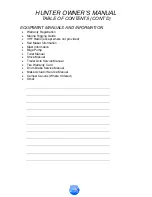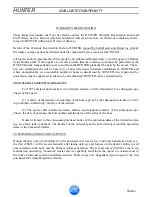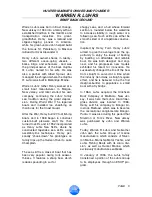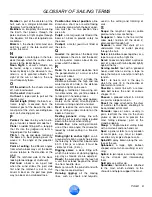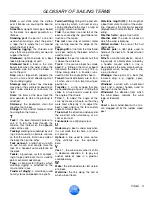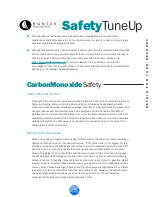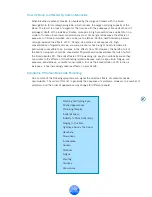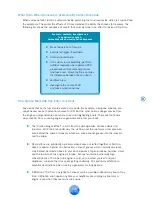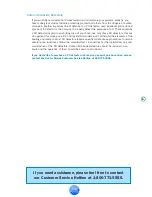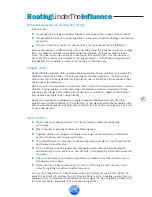
GLOSSARY OF SAILING TERMS
PAGE 9
Stall:
a sail stalls when the airflow
over it breaks up, causing the boat to
lose way.
Stanchion:
upright metal post bolted
to the deck to support guardrails or
lifelines.
Standing part:
the part of a line not
used when making a knot; the part of
a rope that is made fast, or around
which the knot is tied.
Standing rigging:
the shrouds and
stays that are permanently set up and
support the mast.
Starboard:
right-hand side of a boat
looking forward (opp. of
port
).
Starboard tack:
a boat is the star-
board tack when the wind strikes the
starboard side first and the boom is
out to the
port
.
Stay:
wire or rope which supports the
mast in a fore and aft direction; part of
the
standing rigging
.
Steerage way:
a boat has steerage
way when it has sufficient speed to al-
low it to be steered, or to answer the
helm.
Stem:
the timer at the bow, from the
keel upward, to which the planking is
attached.
Sternway:
the backward, stern-first
movement of a boat.
Stringer:
a fore and aft member, fitted
to strengthen the frames.
T
Tack:
1, the lower forward corner of a
sail; 2, to turn the boat through the
wind so that it blows on the opposite
sides of the sails.
Tacking:
working to windward by sail-
ing
close-hauled
on alternate
courses
so that the wind is first on one side of
the boat, then on the other.
Tack pennant:
a length of wire with
an eye in each end, used to raise the
tack of a headsail some distance off
the deck.
Tackle:
a purchase system compris-
ing of rope and
blocks
that is used to
gain mechanical advantage.
Tang:
a strong metal fitting by which
standing rigging
is attached to the
mast or other
spar
.
Tender of dinghy:
a small boat used
to ferry stores and people to a yacht.
Terminal fitting:
fitting at the end of a
wire rope by which a
shroud
or stay
can be attached to the mast, a
tang
or
a
rigging screw/ turnbuckle
.
Tide:
the vertical rise and fall of the
oceans caused by the gravitational at-
traction of the moon.
Toe rail:
a low strip of metal or mold-
ing running around the edge of the
deck.
Topping lift:
a line from the masthead
to a spar, normally the boom, which is
used to raise it.
Topsides:
the part of a boat’s hull that
is above the waterline.
Track:
1, the course a boat has made
good; 2, a fitting on the mast or boom
into which the slides on a sail fit; 3, a
fitting along which a traveller runs,
used to alter the angle of the sheets.
Transit:
two fixed objects are in tran-
sit when seen in line; two transit give
position fix.
Traveller:
1, a ring or hoop that can
be hauled along a
spar
; 2, a fitting that
slides in a
track
and is used to alter
the angle of the
sheets
.
Trim:
1, to adjust the angle of the
sails, by means of
sheets
, so that they
work most efficiently; 2, to adjust the
boat’s load, and thus the fore and aft
angle at which it floats.
True wind:
the direction and speed of
the wind felt when stationary, at an-
chor or on land
.
Turnbuckle:
see
Rigging screw
.
U
Under way:
a boat is under way when
it is not made fast to shore, at anchor
or aground.
Uphaul:
a line used to raise some-
thing vertically, e.g., the spinnaker
pole.
V
Veer:
1, the wind veers when it shifts
in clockwise direction; 2, to pay out
anchor cable or rope in a gradual,
controlled way.
W
Wake:
the disturbed water left
astern
of a boat.
Waterline:
the line along the hull at
which a boat floats.
Waterline length (WL):
the length of
a boat from
stem
to
stern
at the
water-
line
. It governs the maximum speed of
displacement hull
and effects a boats
rating
.
Weather helm:
( opp. of
lee helm
).
Weather side:
the side of a boat on
which the wind is blowing.
Wetted surface:
the area of the hull
under water.
Whisker pole:
a light pole used to
hold out the
clew
of a headsail when
running
.
Winch:
a mechanical device,
consist-
ing usually of a metal drum turned by
a handle, around which a line is
wound to give the crew more purchas-
ing power when hauling taut a line,
e.g. a jib
sheet
.
Windage:
those parts of a boat that
increase
drag
, e.g., rigging, spars,
crew, etc.
Windlass:
a
winch
with a horizontal
shaft and a vertical handle, used to
haul up the anchor chain.
Windward:
the direction from which
the wind blows; towards the wind
(opp. of leeward).
Y
Yawl:
a two masted boat with a miz-
zen stepped aft of the rudder stock/
post.
Summary of Contents for HUNTER 25
Page 55: ...Power Squadron recommendations for maintenance and safe boating PAGE 13A 11...
Page 56: ...Local sailing club or marina s recommendations for maintenance and up keep PAGE 13A 12...
Page 58: ...Spare parts list PAGE 13A 14...
Page 59: ...Dates of practice drills and onboard safety inspections PAGE 13A 15...
Page 60: ...MY PERSONAL PREFERENCES FOR MAINTENANCE ITEMS SAFETY GEAR PAGE 13A 16...
Page 68: ......
Page 76: ......
Page 86: ......
Page 97: ......
Page 98: ......
Page 99: ......
Page 101: ......
Page 103: ......
Page 104: ......
Page 105: ......
Page 106: ......
Page 107: ......
Page 108: ......
Page 109: ......
Page 110: ......
Page 114: ......
Page 115: ......
Page 116: ......
Page 118: ......
Page 119: ......
Page 120: ......
Page 121: ......
Page 122: ......
Page 123: ......
Page 124: ......
Page 125: ......
Page 126: ......
Page 127: ......
Page 128: ......



